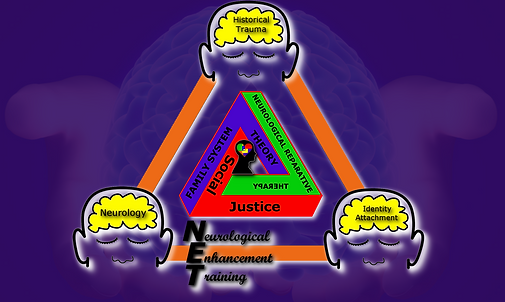Neurological
Enhancement
Training (NET)
The N.E.T model was developed as a model of supervision aimed to help African American therapists in their work with , White-Dominate Culture Clients. The N.E.T. model builds on the Neurological Reparative Therapy frame work, developed by Ziegler (2011) to treat children who have experienced trauma. Ultimately, the goals of the N.E.T model is to increase the higher executive functions of members of subjugated groups when they presented with oppressive stimuli associated with their their groups position within social structures that perpetuate division.
The N.E.T model has been adapted to support subjugated groups across various setting. Theses settings include:
-
Mental Health Professionals and their clients
-
Students of Color attending predominantly White schools of higher education
-
Collegiate Athletes
-
Foster Youth and Foster Parents
-
Aggressor within Domestic Violence Relationships
-
Institutional Structures and Professional Organizations
-
Social Epidemics within at-risk communities
-
Public Schools
-
The NET model integrates 3 areas study: Historical Trauma, Identity/Attachment, and Neurology. Each area is further explained below.
In the past decade, an increasing number of research studies and publications have shined the light on the ways in which parents transfer information, values, and perspectives about ethnicity, race, gender, sexual orientation, religion and social economic status to their children. To highlight this experiences for Native American communities Dr. Brave Heart (1999), coined the term “Historical Trauma.” In the N.E.T model it is our assumption that a historical trauma lens can be applied to any group that has suffered from some type of oppression; this include racial and ethnic communities, LGTQ communities, religious communities, communities who experiences patriarchal systems of oppression, and so on.
How a person perceives themselves as a result of their position within the social structures built upon racism, gender based oppression, hetero-sexism, theocracy, and capitalism, influences how their brain processes stimuli associated with their experiences of historical trauma.
The N.E.T model incorporates social justice and family systems principles to increase our understanding of the influences of historical trauma on the neurological development of subjugated communities. Trauma has shown to increase the reactivity of limbic systems, which trigger the release of stress hormones. Exposure to stress hormones over a long period of time has been shown to have a significant influence on a person’s physical and mental health, The primary goal of the NET model is to enhance the executive functioning of the pre-frontal cortex in individuals who have experienced historical trauma. Increase executive functions have the following benefits:
-
Insight
-
Increase in Morality
-
Empathy
-
Intuition
-
Response Flexibility
-
Emotional Regulation
-
Regulation of body systems
-
Increase ability modulating fear
-
Increase ability to attune to others








